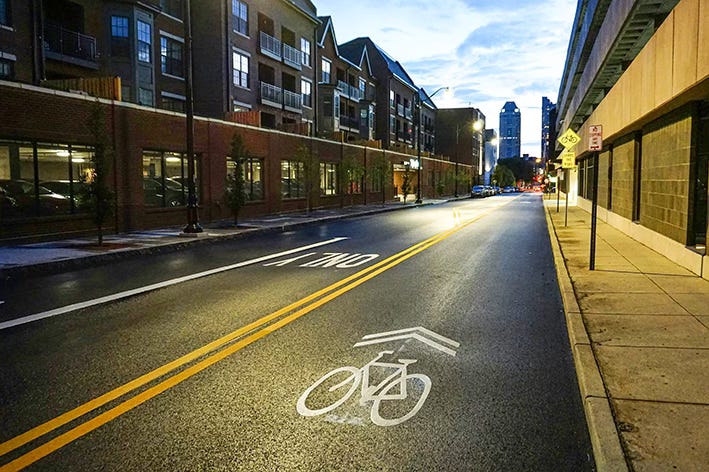Vandalism, Sharrows and Zebras
Or, the trials and tribulations of simply crossing the street in safety
“Our call for evidence revealed a perception of widespread disregard for The Highway Code, particularly the January 2022 changes and particularly by motorists. Individuals report frequently witnessing motorists breaking speed limits, cutting up cyclists, and failing to give pedestrians priority at crossings.” – The Bikeability Trust and Living Streets
This week, a look at what’s going on across the pond.
And a shift from focussing on the young to taking a look at the activities of the more “mature”.
Kevin Cox, a man with plenty to say on the issue of pedestrian safety has been accused of an act of vandalism.
His crime?
To mark out in spray chalk a pedestrian crossing at an intersection near the site where a 64-year-old woman was hit by a car and killed as she tried to cross the road to get to work last year.
It turns out he repeatedly asked officials to provide a formal crossing.
They repeatedly refused.
So, he took, matters into his own hands. He had the decency to inform city hall what he’d done and finally the people in charge of road safety were able to leap into action take him to court – the trial is scheduled for 14 July.
You have to understand that in 2024, 39,345 people were killed in road collisions in the United States. That’s a heckuva lot of people losing their lives. Needlessly.
And when someone gets tired of asking politely for simple safety interventions to be installed and then actively does something about it, the long arm of the law immediately swings into action.
I don’t suggest that people go around randomly chalking crossings onto roads, but I would suggest that highways authorities listen very carefully to concerns from the public about difficulties crossing the street, particularly in areas where people have been killed or injured.
Here in the UK we already have informal zebra crossings installed at some side streets. They lack the Belisha beacons and zig-zag road markings of the formal versions but with the black and white stripes in place they do encourage drivers to give way – which they should do at side streets in any case. If drivers didn’t get the full memo about the Highway Code updates in 2022, the informal zebras are a very useful aide-mémoire.
I’d draw your attention to the recently published ‘Safer Streets for All: The Upcoming Government Road Safety Strategy’, produced by Living Streets and The Bikeability Trust.
Rather worryingly, 31% of drivers said they would turn across a pedestrian trying to cross a side-road… and a cyclist said he was pulled over by the police for riding two-abreast – something else permitted by The Highway Code.
At the time the Code updates were published I couldn’t understand why more wasn’t being done to advertise them. There were few and fleeting mentions on the news but that was it.
And more worryingly, why aren’t all police officers up to date with it?
If the people charged with our safety don’t even know what’s going on, it’s not surprising that despite being at the top of the hierarchy of road users, pedestrians and cyclists are still getting a raw deal.
Safer Streets for All does suggest the introduction of side-road zebra crossings to ensure street layout makes it easy for drivers to comply with the Code. It’s been found there is 80% to 90% compliance from drivers stopping at a side-road with an informal zebra crossing.
And TRL (Transport Research Laboratory) concluded that:
“Side road zebras (without beacons) substantially improve pedestrian priority and safety at side road crossings, without causing unacceptable delay or confusion for motorists. Well-designed raised crossings deliver the highest compliance and should be strongly encouraged.”
No argument here. It’s a no-brainer, surely?
As is a ban on pavement parking. According to Safer Streets for All, since pavement parking was banned in London in 1974:
“… the number of private motor vehicles registered on UK roads has almost trebled, from 13.95 million to 41.2 million. Pedestrians in towns and cities across England and Wales now face obstruction on a similar scale to that which required a pavement parking ban in 1970s London – a similar national policy is needed to restore their freedom.”
Too right. It’s basically carmageddon in the street where I live. There is very little room for roller-skating or hula-hooping… and we then we wring our hands and despair that children don’t play out enough anymore. Completely ignoring the fact that regardless of the risk of a collision, the air pollution created by all these cars will probably finish them – and us – off anyway.
And finally, back in the States, a good news story!
(Two negatives do make a positive!)
A positive link has been found between the provision of cycle infrastructure in the form of protected bicycle lanes and bicycle commuting!
Yowza!
Who would have thought such a thing was possible?
Meanwhile, “sharrows” – shared lane markings that put cyclists on the carriageway – were not so successful. No huge surprise there:

Again from the top: full segregation between vehicles and cyclists is needed. See LTN1/20.
Build it and they will come. You get who you invite.
Question: Given the lack of compliance, do the 2022 Highway Code updates need to be re-launched?
#livingstreets #bikeabilitytrust #pedestrians #cyclists #sharrows #highwaycode #ltn120 #saferstreetsforall




